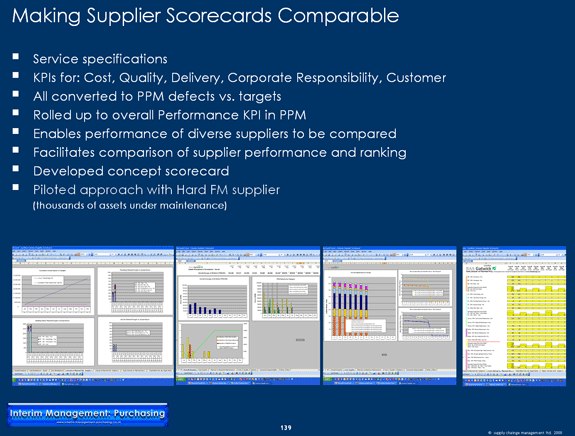
|

Supplier Relationship Management (SRM) Scorecards
Scorecards are one of the most fundamental managment tools / techniques for any vendor / supplier relationship management (SRM) team.

Although scorecards form only one of many elements of the full suite of SRM management tools, the maturity of an SRM team's scorecards can be a helpful first indicator of the state of a team's processes.
Measuring Direct Supplier Performance
Manufacturing businesses are usually the most mature when it comes to objectively measuring: cost, quality, delivery, (and sometimes, innovation and service too) of their direct materials suppliers. Best practise though is about not only measuring each supplier's performance and feeding it back, but about setting targets and engendering a spirit of positive competition amongst the supplier base; and rewarding the best performers.
Mature systems for achieving this, involve a means of amalgamating the separate metrics into an overal score and producing a "leader-board" to rank and publish, the relative positions of suppliers, for example over the internet. This is then followed up by regular supplier conferenes to establish policy targets and encourage improvements. It should almost go without saying, that for suppliers to take such mechanisms seriously the methodology behind the measurement process needs to be well thought through and fair. The automotive industry, particularly the OEMs are very strong when it comes to this sort of thing. A key challenge seems to be; getting the same principle adopted to measure and compare the performance of indirect (or general expenses) suppliers.
Measuring Indirect Supplier Performance Using Supplier Relationship Management SRM Scorecards
In businesses that have a relatively formalised approach to measuring the performance of indirect suppliers, often the construction of the scorecards used for different suppliers vary significantly. More importantly though, there's usually no way that the performance of diverse indirect suppliers, measured by entirely different scorecards, can be compared; which means that its pretty much impossible to try to get suppliers to compete against each other in the way that mature direct material suppliers can be encouraged to. The question that typically gets asked is something like: "How can you legitimately compare the performance of a Hard FM supplier with the performance of an outsourced IT service provider?" Actually though, with a little effort the answer is quite simply: "in a similar way that you'd compare the performance of a supplier that supplier of 'widgit A' with the performance of a supplier that provides a completely different product; 'widgit B' ".
Common Supplier Relationship Management (SRM) Scorecard
At this point its probably better to take a look at a spreadsheet that begins to illustrate how comparing the performance of indirect suppliers might be achieved, from more of a practical perspective. Developed during a Supplier Management Transformation Programme, it's a quite helpful way to illustrate some of the key principles:
Common Scorecard 
The above Excel workbook is split into several different spreadsheets, with the objective of characterising suppliers' performance reasonably comprehensively, but without pushing the scorecard beyond the point of diminishing returns and making the process unnecessarily beaurocratic. However in practise, the point of diminishing returns will be different for each supplier, because it's will always be more important to manage some suppliers more closely than others. This workbook has been split into a spreadsheets for each of the following performance criteria and goes into more detail than may be necessary in practise, to maket the point..
- Cost
- Quality
- Delivery
- Corporate Responsibility
- Other (could be "Innovation" / "Service" etc)
- Client/Customer Responsibilities
The metrics are summarised in a series of standard graphs at the front ot the workbook.
Setting Performance Targets for Criteria
Going back to our example, the delivery performance of an outsourced IT supplier will be characterised differently from a Hard FM supplier, but performance targets should be set fairly and in a consistent manner; and always with a view towards what is necessary from the perspective of customers further down the supply chain.
Parts Per Million (PPM) or Percentages ?
Within each spreadsheet deviations from each target can be measured. These deviations can be expressed most simply as percentages. However, the parts per million (PPM) approach is used because it offers much higher resolution with which to drive the supplier performance improvement process. For example, it emphasises to suppliers that whilst performance of 98% compared to a target of 100%, sounds pretty good from most people's perspective; when it's expressed as 20,000 parts per million (PPM) defects compared to a target of zero defects (or even say, 1000 PPM); there's still a long way to go.
Using Parts Per Million (PPM) to Normalise Supplier Performance
For each of the measurement criteria within each spreadsheet in the above scorecard, an average PPM score can be calculated. So the "Delivery" score for our outsourced IT services supplier may be comprised of entirely different sub-criteria from that of our Hard FM supplier. In any event though, since the differing mixes of criteria and targets for different types of suppliers objectively and realistically reflect the aspirations of the downstream supply chain, when rolled up into a combined PPM score in each ("Delivery", "Quality" etc.) spreadsheet, they're valid and also comparable; in exactly the same way that say, the Quality performance of the supplier of 'widget A' can be compared to the Quality performance of the supplier of 'widget B' despite their design specifications being entirely different. Of course, the same is true for the overall PPM score which is calculated as the average of all the individual metrics in the separate spreadsheets.
Conclusion
So having established some basic principles, it is possible to compare the performance of even diverse indirect suppliers and encourage and reward competition between them as it is with direct suppliers.
More Supplier Relationship Management (SRM) Information
© www .interim-management-purchasing.co.uk December 2012 |


   Supplier relationship management (SRM) was a major driver of performance improvement in the development the category management strategy for loss adjusters during a post-merger integration programme in the financial services industry. Supplier relationship management (SRM) was a major driver of performance improvement in the development the category management strategy for loss adjusters during a post-merger integration programme in the financial services industry.
Previously it had been impossible to compare supplier performance on a like for like basis.
Senior leaders from the approved supplier list of loss adjusters (the panel) were invited to attend a major workshop (about 40 people) to review and agree a common form of performance measurement and comparison - an industry first. Improvement Programmes comprised of several improvement initiatives, were then agreed individually with suppliers.
The client's finance team independently validated savings estimates of £ 3.5m per annum on the basis of this element of the assignment alone.
Within this broader financial services procurement category management transformation, the savings associated with resourcing loss adjusters were substantially greater than even this.
|

